Leafy greens stand out as arguably the most nutritious category of vegetables.
These particular vegetables are the upper leaves of vegetables, and they provide a wealth of essential vitamins and minerals.
While typical examples like kale and spinach often take the spotlight, there are many lesser-known, equally nutritious varieties too.
This article presents a list of 21 leafy green vegetables alongside their images and nutritional benefits.
Nutritional data is based on raw weight per 100 grams unless otherwise stated. The data source is the USDA’s FoodData Central database.
Percent daily values (% DV) were calculated using the FDA’s published daily values.
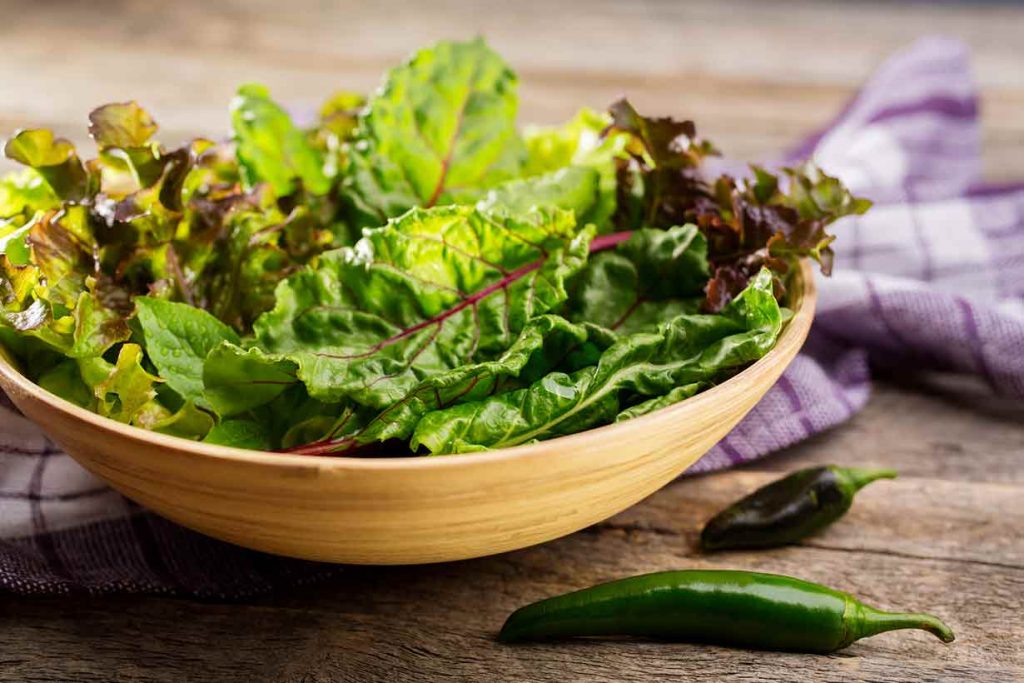
Table of contents
- Varieties of Leafy Green Vegetables
- 1) Arugula
- 2) Beet Greens
- 3) Bok Choy
- 4) Broccoli Rabe
- 5) Chinese Broccoli (Gai Lan)
- 6) Collard Greens
- 7) Dandelion Greens
- 8) Endive
- 9) Green Amaranth Leaves
- 10) Iceberg Lettuce
- 11) Kale
- 12) Malabar Spinach
- 13) Mustard Greens
- 14) Napa Cabbage
- 15) New Zealand Spinach
- 16) Purslane
- 17) Romaine Lettuce
- 18) Spinach
- 19) Swiss Chard
- 20) Turnip Greens
- 21) Watercress
- What General Benefits Do Leafy Green Vegetables Have?
- Cooking Methods and Consumption Considerations
- How To Add Leafy Greens To Your Diet
- Final Thoughts
Varieties of Leafy Green Vegetables
1) Arugula
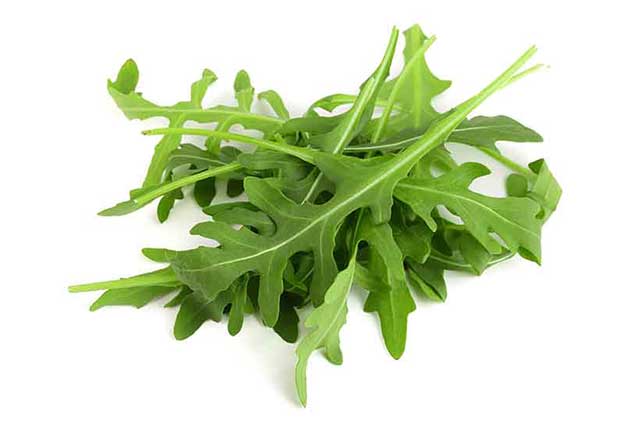
Arugula, perhaps the most difficult vegetable to pronounce on this list, also answers to the name “rocket.”
This leafy green vegetable is very flavorful, and it can enhance the taste of hot cooked dishes and sauces, or lend its characteristics to a salad.
Per 100 grams, it provides (1):
- 25 calories
- 3.65g carbohydrates
- 1.6g fiber
- 0.66g fat
- 2.58g protein
From a nutritional standpoint, arugula is a good source of folate and vitamins C and K, alongside san array of other essential nutrients.
Beyond its range of vitamins and minerals, arugula also contains potentially health-protective compounds, including erucin, glucosinolates, and nitrates. These compounds, among their various merits, are associated with the potential to lower blood pressure and a potential reduction in cancer risk (2, 3).
2) Beet Greens
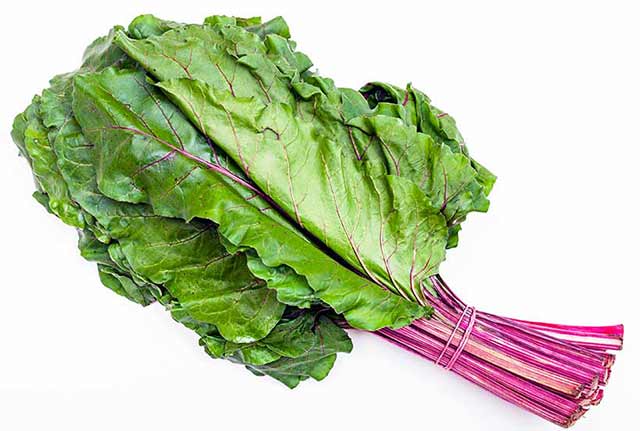
Beet greens, boasting an attractive visual appearance with their long purple stalks, are the upper leaves of beets.
Although not as famous as the root vegetable they cover, beet greens offer a lot nutritionally.
Per 100 grams, beet greens offer (4):
- 22 calories
- 4.33g carbohydrates
- 3.7g fiber
- 0.13g fat
- 2.2g protein
In addition, beet greens provide a substantial source of vitamins A, C, and K1: 35%, 33%, and a significant 333% of the daily value for each of these essential nutrients, respectively (4).
Alongside these nutritional attributes, beet greens also offer a modest amount of dietary fiber and protein.
For a more comprehensive exploration of this vegetable, see this full guide to beet greens for a look at their potential benefits.
3) Bok Choy
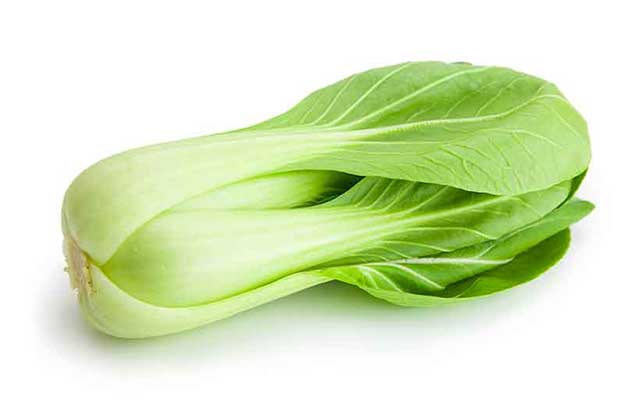
Sometimes people refer to bok choy as “Chinese cabbage.” However, despite its Chinese origins, the vegetable is available worldwide.
Remarkably hydrating, bok choy has a composition exceeding 95% water content (5).
Notably, this vegetable also has a decent nutritional profile, delivering the subsequent nutrients per 100 grams (5):
- 13 calories
- 2.18g carbohydrates
- 1.0g fiber
- 0.2g fat
- 1.5g protein
This leafy green also provides significant amounts of these vitamins:
- Vitamin C: 50% DV
- Vitamin K1: 38% DV
- Vitamin A: 25% DV
Given bok choy’s near absence of calories (13 kcal per 100 grams), it is exceptionally nutrient dense.
For more information, see this guide to bok choy.
4) Broccoli Rabe
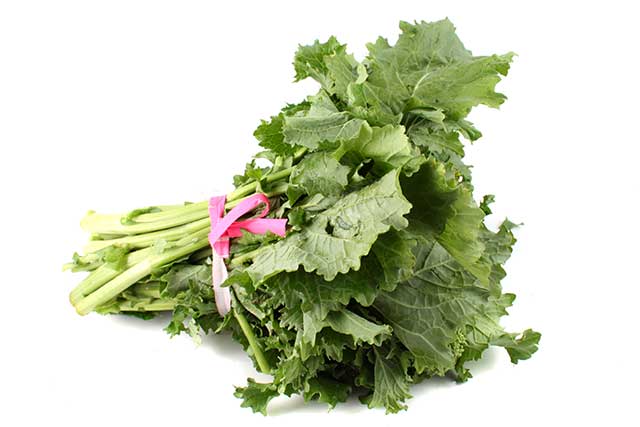
Broccoli rabe, a green leafy vegetable characterized by its long, slender stalks, sometimes goes by the name “rapini.”
It has a heightened bitterness level compared to traditional broccoli, with a robust and earthy flavor.
Cooking this vegetable is essential, and it can taste quite nice when combined with a dash of olive oil and a sprinkle of salt.
In terms of nutritional composition, broccoli rabe offers nearly 200% of the DV for vitamin K1 and good quantities of vitamins A and C, folate, and manganese. It has the following nutritional composition per 100 grams (6):
- 22 calories
- 2.85g carbohydrates
- 2.7g fiber
- 0.49g fat
- 3.17g protein
5) Chinese Broccoli (Gai Lan)
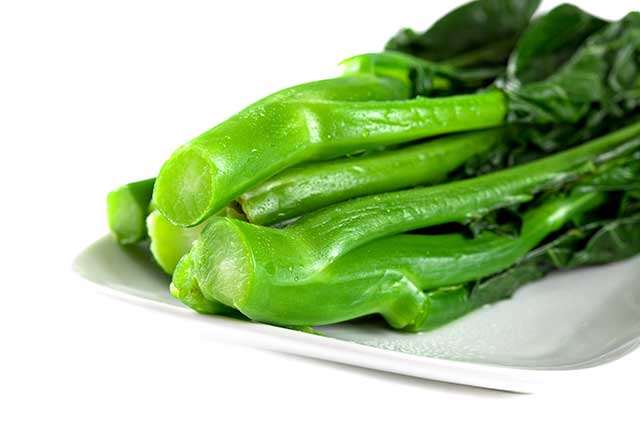
Known as ‘Gai Lan’ in China, Chinese broccoli is a robust-tasting green vegetable, and a member of the same family as traditional broccoli.
Diverging from the florets of its relative, Chinese broccoli has elongated, slender stalks complemented by dark green leaves.
Although it shares some likenesses to broccoli in terms of flavor, it has a stronger taste and more bitter notes.
Nutritionally, it is a good source of many nutrients, and it is particularly high in vitamins A, C, K1, folate, and manganese. It has the following nutritional properties per 100 grams (7):
- 26 calories
- 4.67g carbohydrates
- 2.6g fiber
- 0.76g fat
- 1.2g protein
6) Collard Greens
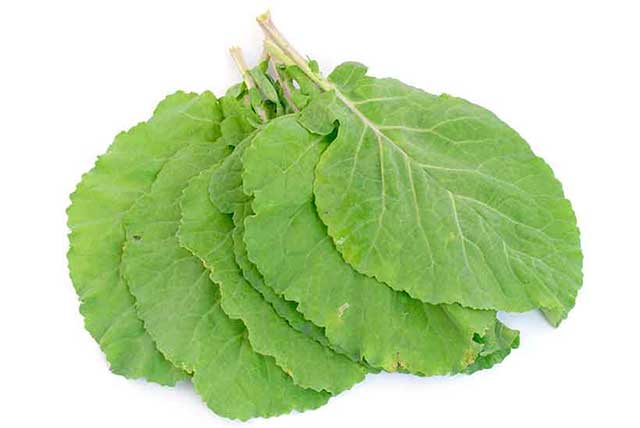
Collard greens are a deep green leafy vegetable in the same family as kale.
They are popular around the world and can be used in a variety of ways, from soups and stews to side dishes.
Like many other green vegetables, collard greens are a good source of vitamin K1, providing more than 364% of the daily value per 100 grams. They are also a rich source of vitamins C and K1.
Here are the nutritional values of collared greens per 100 grams (8):
- 32 calories
- 5.42g carbohydrates
- 4.0g fiber
- 0.61g fat
- 3.02g protein
7) Dandelion Greens
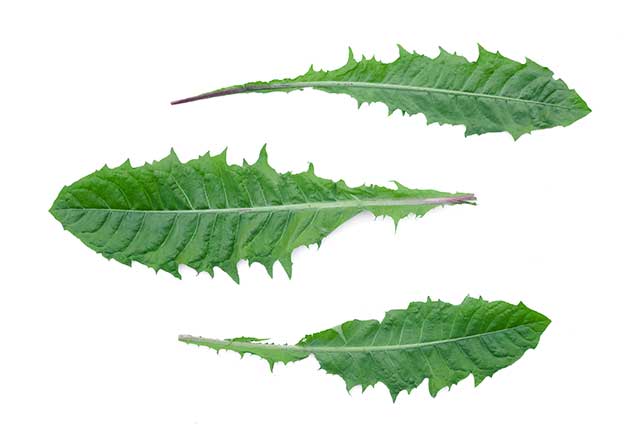
Dandelion greens have a crisp, bitter, and nutty flavor. They are often used in salads, but they can also be cooked.
On their own, the taste can be a little bland, but they can add a lot of flavor to salad when paired with other ingredients.
Dandelion greens are also one of the most nutrient-dense green vegetables. Here are their basic nutritional values per 100 grams (9):
- 45 calories
- 9.2g carbohydrates
- 3.5g fiber
- 0.7g fat
- 2.7g protein
They also offer significant amounts of the following nutrients per 100 grams (9):
- Vitamin K1: 649% DV
- Vitamin A: 56% DV
- Vitamin C: 39% DV
8) Endive
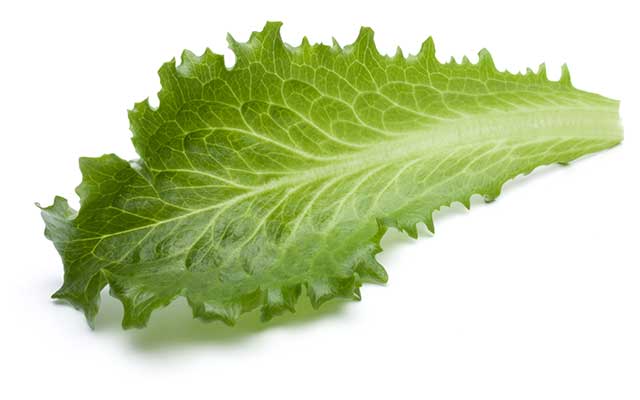
Endive is a typical leafy salad green. It is often mixed with olive oil, balsamic vinegar, and various kinds of cheese and vegetables.
The taste profile of endive depends on how it is used:
- Raw: In its raw state, endive is crispy and slightly bitter.
- Cooked: After cooking, endive is very soft and mild in flavor.
Nutritionally, endive is particularly rich in folate and vitamin K1. Per 100 grams, it provides 36% and 193% of the daily value for these nutrients, respectively (10).
This vegetable also offers good amounts of vitamins A and C and the mineral manganese.
Here are its basic nutritional values (10):
- 17 calories
- 3.35g carbohydrates
- 3.1g fiber
- 0.2g fat
- 1.25g protein
Escarole is one of the two main types of endive. See the following article for a comprehensive guide to its nutritional benefits:
5 Benefits of Escarole (With Full Nutrition Facts)
9) Green Amaranth Leaves
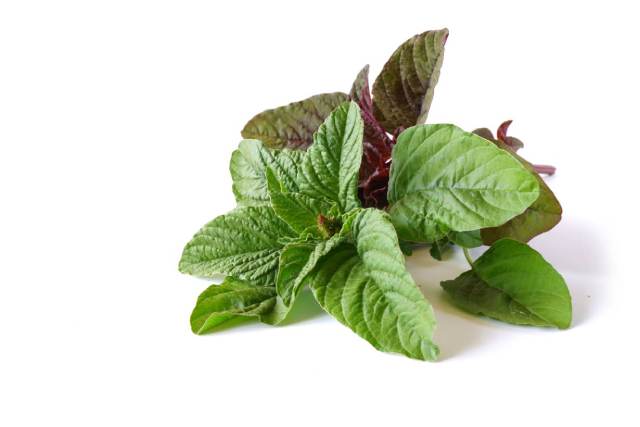
Green amaranth leaves have a mildly sweet, nutty, and earthy flavor. They share some taste and nutritional characteristics with spinach, and some people call them “Chinese spinach” in reference to these similarities.
Green amaranth leaves offer significant nutritional value, and they provide high levels of the following nutrients per 100 grams (11):
- Vitamin K1: 950% DV
- Manganese: 38% DV
- Vitamin A, RAE: 16% DV
The basic nutritional properties of this nutritious leafy green are as follows (11):
- 21 calories
- 4.11g carbohydrates
- 0.18g fat
- 2.11g protein
See this complete nutritional guide to green amaranth leaves for more information.
10) Iceberg Lettuce
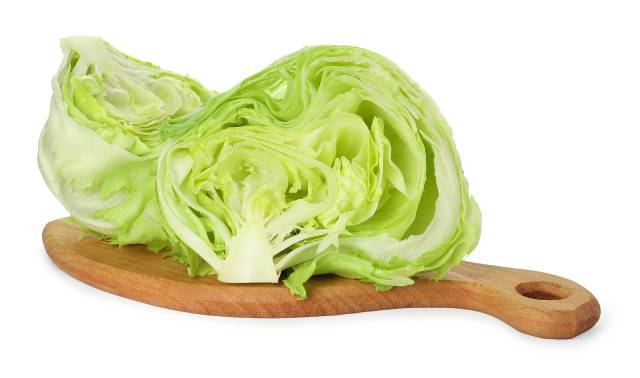
Iceberg lettuce is a crispy leafy vegetable with a high water content. It has a crunchy texture and a refreshing, mild taste, which makes it a popular addition to sandwiches and various dishes.
Although iceberg lettuce is low in calories, it is not as nutrient-dense as other leafy greens.
However, it does provide a moderate amount of vitamin K, equal to 20% of the daily value per 100 grams (12).
Here is the nutritional composition of iceberg lettuce per 100 grams (12):
- 14 calories
- 2.97g carbohydrates
- 1.2g fiber
- 0.14g fat
- 0.9g protein
11) Kale
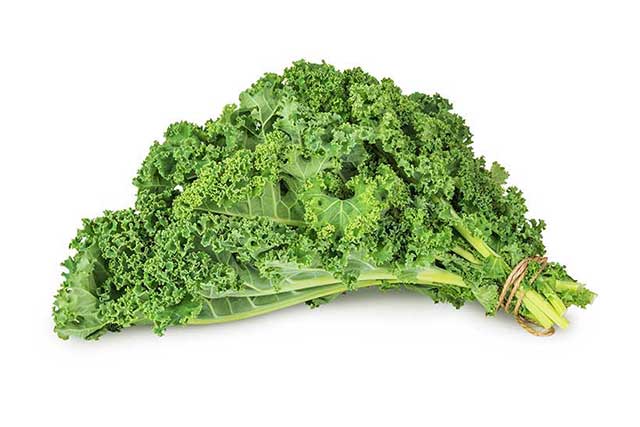
Over the past decade or so, kale has become increasingly popular as a so-called “superfood.”
However, the “superfood” definition is unhelpful, as it is our overall diet that matters more than any singular food choice.
That said, kale is among the most nutrient-rich leafy greens.
Similar to spinach, kale offers a substantial amount of vitamin A carotenoids and K1.
Per 100 grams, kale provides (13):
- Calories: 35 calories
- 4.42g carbohydrates
- 4.1g fiber
- 1.49g fat
- 2.92g protein
Kale offers a substantial 27% of the daily value for vitamin A and over 300% of the daily value for vitamin K (13).
Although kale offers these two vitamins in higher concentrations, its overall range of nutrients is not as broad as spinach, and it has twice the calorie content.
Notably, kale stands out as an excellent source of carotenoids like lutein and astaxanthin, which may help to protect our eyesight (14).
Moreover, a randomized trial highlighted kale’s ability to potentially lower postprandial blood glucose levels following a meal (15).
12) Malabar Spinach
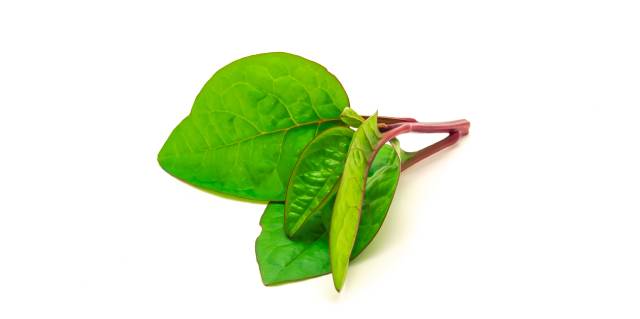
Malabar spinach is a well-liked leafy green vegetable, but it is quite different from regular spinach and belongs to an entirely distinct family of plants known as Basellaceae (16).
Its flavor deviates from that of many other leafy greens too, and it has a mild taste with subtle notes of citrus.
In terms of nutrition, malabar spinach offers the following composition per 100 grams when cooked (17):
- 23 calories
- 2.71g carbohydrates
- 2.1g fiber
- 0.78g fat
- 2.98g protein
13) Mustard Greens
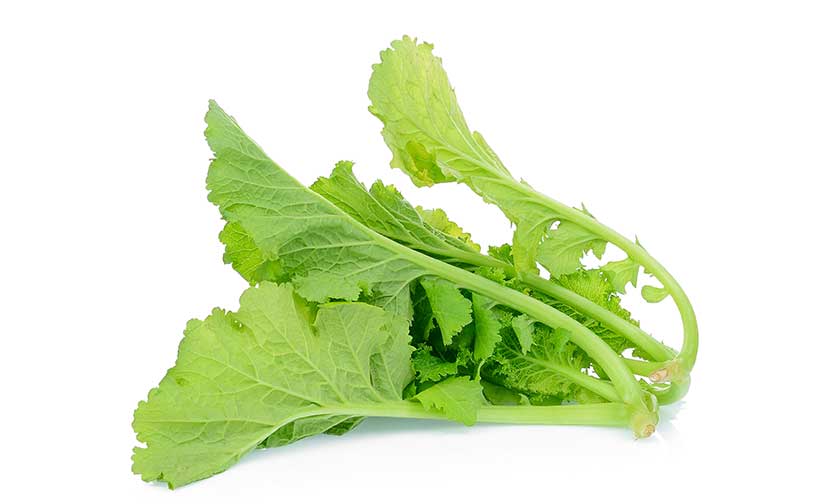
Mustard greens are a nutritious leafy vegetable, characterized by their peppery and slightly hot taste.
For anyone who dislikes kale for its bitterness, it may be a good idea to steer clear of mustard greens too.
However, if you can handle the bitter, peppery taste, these leafy greens are rewarding in the nutrient compartment. In a 100-gram serving, mustard greens deliver an impressive 200% or more of the daily value for vitamin K1 and nearly 100% of the recommended DV for vitamin C (18).
It has the following basic nutritional properties (18):
- 27 calories
- 4.67g carbohydrates
- 3.2g fiber
- 0.42g fat
- 2.86g protein
Mustard greens belong to the plant family known as Brassica. A number of studies demonstrate the potential anti-inflammatory properties of the compounds present in these plants (19).
14) Napa Cabbage
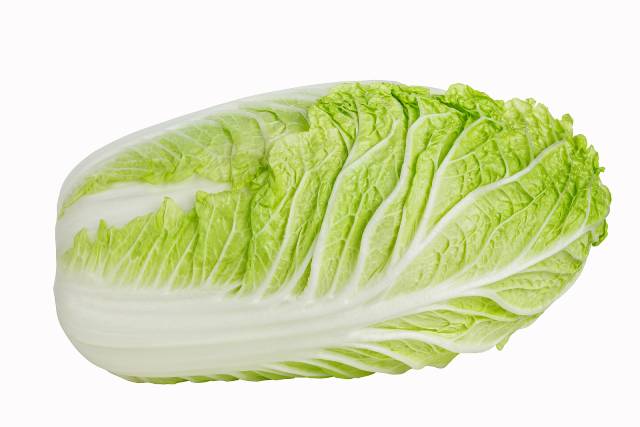
Napa cabbage, often referred to as ‘Chinese cabbage,’ enjoys popularity as a cabbage variety that offers a crunchy teexture.
One of its notable uses is as the primary ingredient in the Korean fermented dish known as kimchi.
Just like many other leafy green vegetables, napa cabbage has low calorie and carbohydrate counts while boasting a substantial vitamin and mineral profile.
When cooked, a 100-gram portion of napa cabbage provides the subsequent nutritional values (20):
- 12 calories
- 2.23g carbohydrates
- 0.17g fat
- 1.1g protein
15) New Zealand Spinach
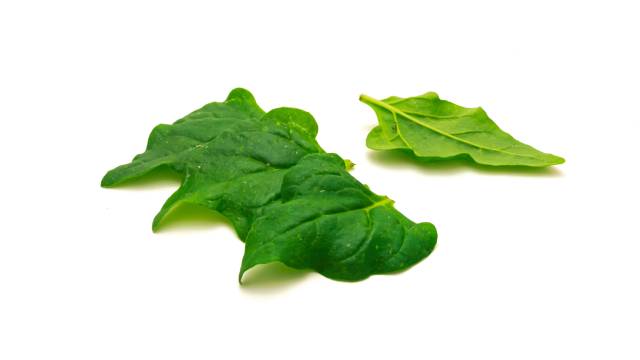
New Zealand spinach might not be as familiar as other leafy greens, but it is a nutritious one.
Interestingly, despite sharing the term ‘spinach’ in its name, it is not closely related to common spinach. While its use and preparation are similar in some ways, it has a milder taste and a softer texture.
100 grams of New Zealand spinach provides the following nutritional values (21):
- 14 calories
- 2.5g carbohydrates
- 1.5g fiber
- 0.2g fat
- 1.5g protein
It is also an excellent source of vitamin K, offering 280% of the daily value.
16) Purslane
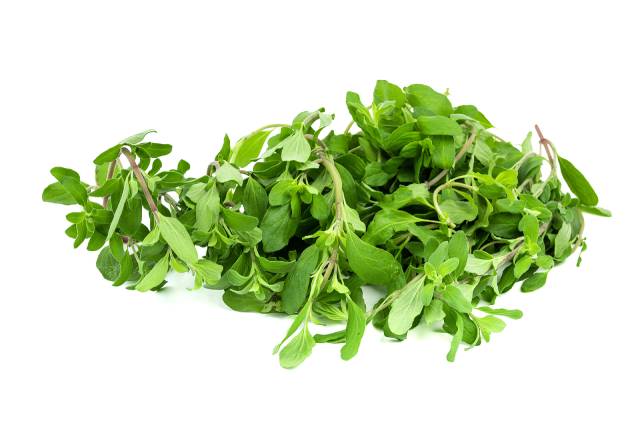
Although often labeled as a weed, purslane is an edible leafy green vegetable consumed by people worldwide (22).
There is good nutritional cause to eat purslane, too, as it contains a diverse array of nutrients (22).
Per 100 grams, here is the basic nutritional composition of purslane (23):
- 20 calories
- 3.39g carbohydrates
- 0.36g fat
- 2.03g protein
17) Romaine Lettuce
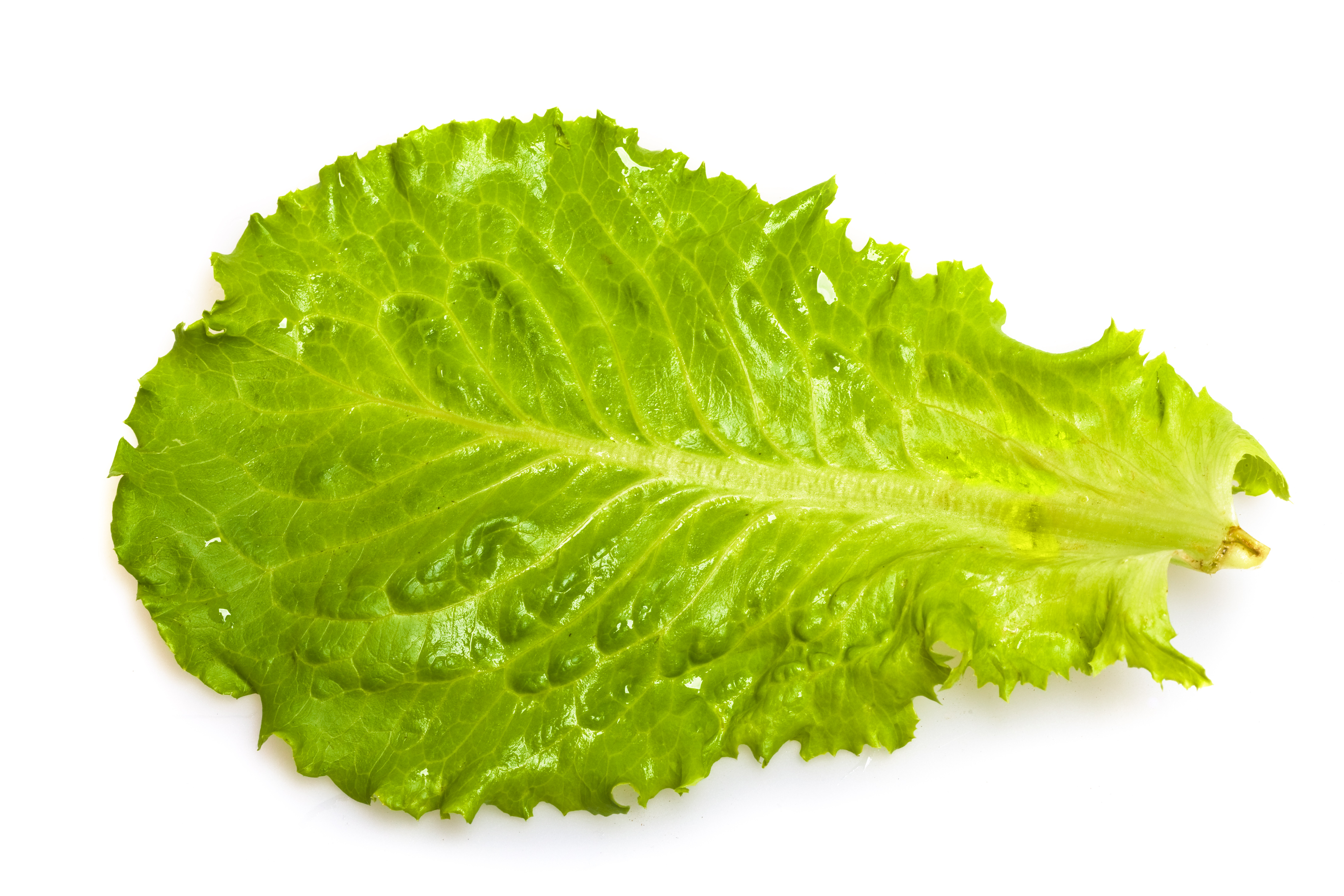
It is fair to say that lettuce reigns as the most famous leafy green in the world.
It seems to make an appearance everywhere, and you’re almost sure to find lettuce whether you’re eating a leafy salad or a cheeseburger.
It is worth highlighting that the nutritional profiles of different lettuce types diverge, with romaine offering higher nutritional value than iceberg lettuce.
For a closer look, here’s the nutritional composition per 100 grams of romaine lettuce (24):
- 17 calories
- 3.29g carbohydrates
- 2.1g fiber
- 0.3g fat
- 1.23g protein
It also provides high amounts of vitamin K1 (85% DV) and folate (32% DV) (24).
18) Spinach
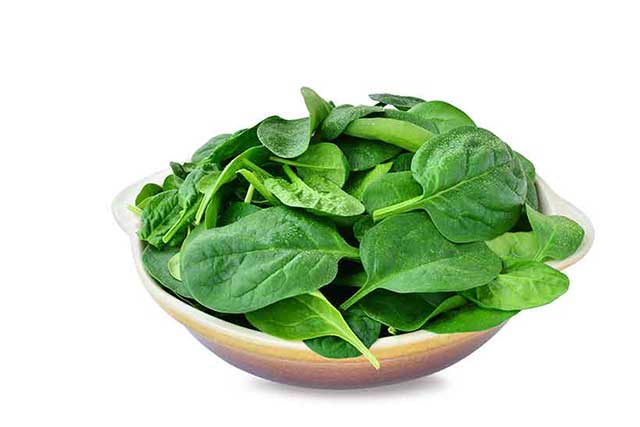
It is hard to beat spinach for the nutritional value it provides.
This popular vegetable boasts a significant source of provitamin A carotenoids, amounting to an impressive 52% of the daily value for vitamin A. Spinach is also an excellent provider of vitamin K1, offering over 400% of the daily value (25).
The basic nutritional breakdown of spinach per 100 grams is as follows (25):
- 23 calories
- 3.63g carbohydrates
- 2.2g fiber
- 0.39g fat
- 2.86g protein
Beyond its rich nutrient content, spinach also plays host to a range of flavonoids, such as quercetin and kaempferol. These compounds may potentially have anti-inflammatory properties (2).
Moreover, a recent randomized controlled trial showcased spinach’s potential to possibly improve arterial stiffness, hinting at potential cardiovascular benefits (26).
See this full guide to spinach for more information.
19) Swiss Chard
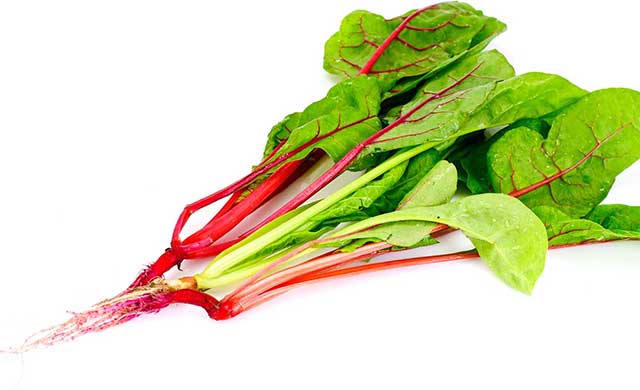
Despite its name, Swiss chard does not hail from Switzerland, and the origins of the name remain a mystery.
This leafy green has large dark green leaves and reddish-purple stalks, prompting visual comparisons to beet greens.
Its nutritional profile is impressive, providing a range of vitamins and minerals. On this note, 100 grams provide a striking 692% of the daily value for vitamin K1 (27).
Swiss chard also contains a good provision of carotenoids, vitamin C, and magnesium.
It has the following basic nutritional properties per 100 grams (27):
- 19 calories
- 3.74g carbohydrates
- 1.6g fiber
- 0.2g fat
- 1.8g protein
Swiss chard works well in salads, and when paired with olive oil, it better absorbs the fat-soluble vitamins it holds while boosting the taste (12).
20) Turnip Greens
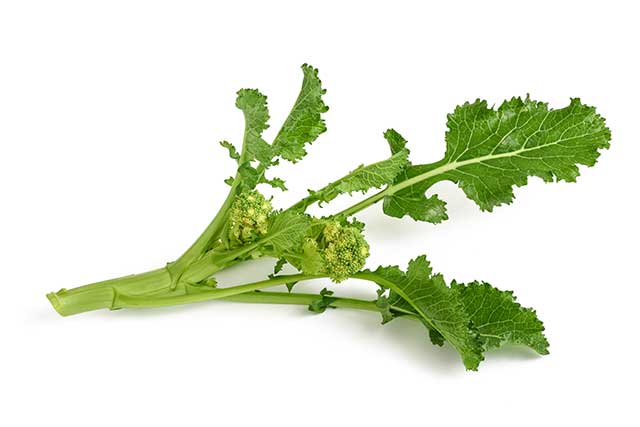
Turnip greens might not be a dietary staple, but these green veggies are another nutritious choice.
While they don’t quite match spinach for nutrient density, turnip greens exceed the recommended daily values of vitamins C and K in a 100-gram serving. These nutritious leaves are a rich source of carotenoids, too (28).
Here’s a look at their basic nutritional profile per 100 grams (28):
- 32 calories
- 7.13g carbohydrates
- 3.2g fiber
- 0.3g fat
- 1.5g protein
Turnip greens also contain glucosinolates. These compounds are a type of phytonutrient that some researchers believe may have anti-cancer benefits (29, 30).
21) Watercress

Classed as a type of “microgreen,” watercress is one of the most visually surprising leafy green vegetables.
Although these little green sprouts look so small and light, they pack a strong nutritional punch.
In a 100-gram portion, watercress provides the following nutritional values (31):
- 11 calories
- 1.29g carbohydrates
- 0.5g fiber
- 0.1g fat
- 2.3g protein
Notably, watercress also offers more than 200% of the daily value for vitamin K1 and contains significant quantities of carotenoids and vitamin C.
There are also some interesting studies involving watercress. For instance, a recent randomized controlled trial involving smokers had participants consume 85 grams of watercress per day over an eight-week period.
By the study’s end, these smokers showcased elevated levels of plasma antioxidants, like lutein and beta-carotene. Additionally, they had decreased markers of DNA damage (32).
What General Benefits Do Leafy Green Vegetables Have?
Broadly, all leafy greens share favorable nutritional characteristics:
- They boast high vitamin and mineral levels for relatively few calories.
- They contain good amounts of dietary fiber.
- They are a notable source of phytochemicals.
In relation to the latter point, leafy greens provide a wide range of phytochemicals, which are compounds found in plants that exert biological effects on the body.
Although research remains ongoing, it is thought that diets high in phytochemicals can have a health-protective effect on human health (33).
Leafy greens typically contain high amounts of carotenoids, chlorophyll, and polyphenols (34, 35, 36).
Cooking Methods and Consumption Considerations
To start, it is worth highlighting that leafy green vegetables can be enjoyed whether cooked or raw.
The cooking process does clearly impact the texture and flavor of these vegetables, creating differences subject to personal taste preferences.
However, both cooked and raw options provide an excellent range of nutrients.
With that said, it is important to consider how cooking leafy greens and the method used to do so can influence their nutritional value.
Vitamin Degradation
Certain nutrients in leafy greens, such as vitamin C, are vulnerable to heat. This means that cooking them will slightly degrade their vitamin C content. Boiling, in particular, tends to have a more pronounced impact on lowering vitamin C content (37, 38, 39).
Potential Food Poisoning
It is worth noting that leafy green vegetables can be vulnerable to bacteria that potentially cause foodborne illnesses (40, 41, 42).
Following proper storage measures and cooking the vegetables at high temperatures are ways to help lower this risk.
Bioavailability of Nutrients and Polyphenols
While cooking may degrade the content of vitamin C in leafy greens, it may elevate the bioavailability of other nutrients.
In this regard, cooking can break down the cell walls of plants, which makes it easier to absorb the nutrients stored within the vegetable (43, 44).
Interestingly, a study published in 2018 examined how cooking six leafy green vegetables impacted their polyphenol and carotenoid content (45). The study found that while frying reduced polyphenol, flavonoid, and carotenoid activity, steaming and boiling had a more varied effect.
On this note, steaming and boiling better preserved the phytochemical content of the leafy greens. Additionally, the content of polyphenols and flavonoids actually increased in some leaves. The researchers hypothesized that this was due to making the phytochemicals more bioaccessible.
For more on the comparative values of cooked and raw vegetables, see this complete guide below:
Raw vs. Cooked Vegetables: Which Are Better For You?
How To Add Leafy Greens To Your Diet
The great thing about leafy greens is their versatility and ease of use, which is often much simpler than people may assume.
For instance, these greens only need a few minutes of heat to cook.
This simplicity allows their incorporation into various dishes just for the final few minutes of cooking. They will work well in pretty much any dish, including:
- Curries
- Omelets and other egg-based dishes like scrambled eggs
- Pasta and rice-based dishes
- Pizza (add a few minutes before the pizza finishes cooking)
- Soups and stews
- Stir-fries
Additionally, raw leafy greens work well in a salad. Combine them with a favored protein source, vegetables of choice, a drizzle of olive oil, a drop of balsamic vinegar, a squeeze of fresh lemon juice, and a dash of salt and black pepper to suit taste preferences.
Final Thoughts
The leafy greens featured in this list are some of the most nutritious vegetable options.
Overall, consuming leafy green vegetables is a straightforward way to bolster our intake of essential nutrients.
For further vegetable insights, see this guide to 15 healthy types of root vegetables.
Alternatively, explore this guide to the most fiber-rich vegetables.

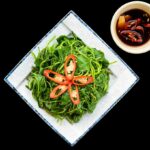

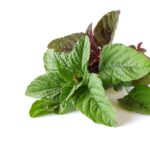
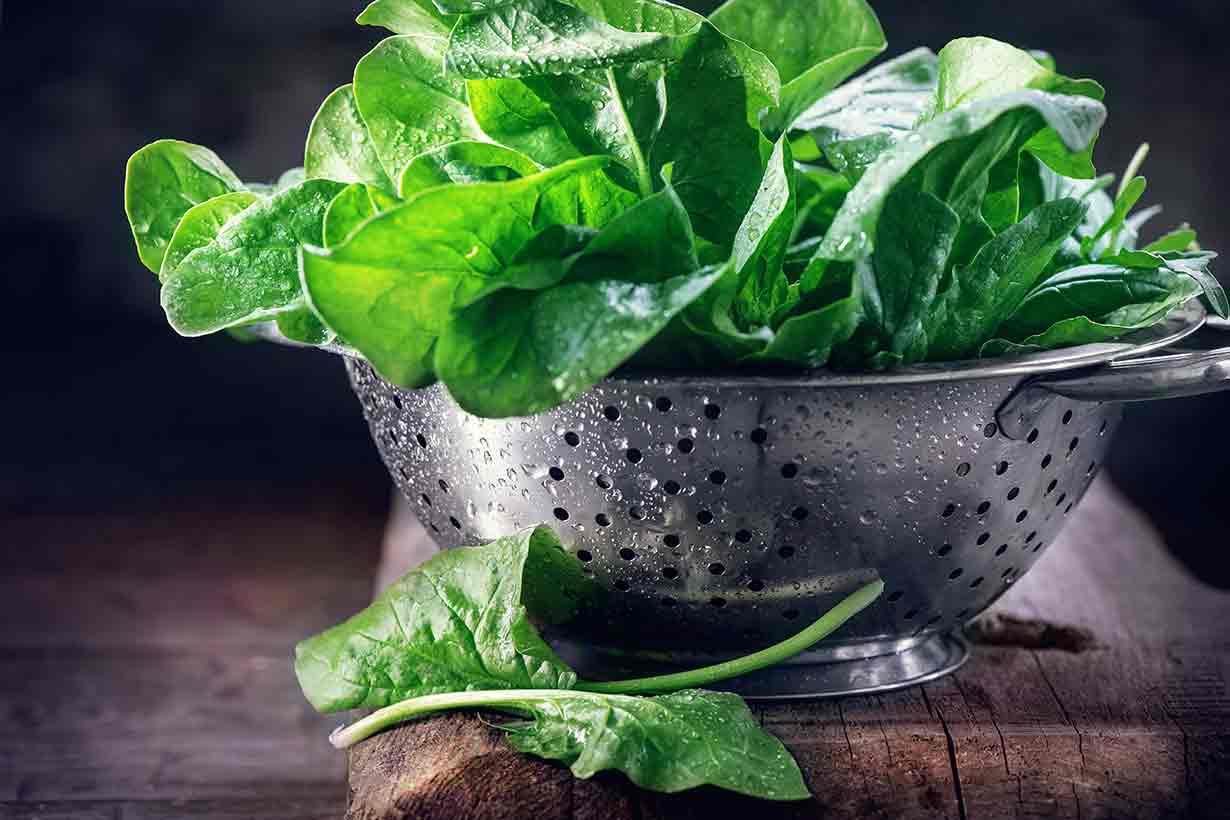

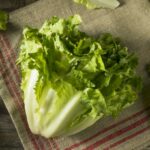

Great information, as always. With leafy greens, I find that there’s often a temptation to assume that one or two are better because of their nutritional profile. Yet, the healthiest choice tends to be to include a variety in your diet.